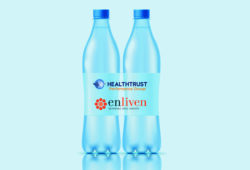Innovations in vaccine formulation may help prevent a “tripledemic”
Respiratory virus season is upon us, and with flu, respiratory syncytial virus (RSV) and COVID-19 potentially circulating simultaneously, the impact on patients, staff and healthcare facilities can be considerable. But for the first time, vaccines for all three viruses are available to help reduce severe disease and protect others. Here is what healthcare organizations need to know about infection prevention this year.
The first RSV vaccines
One of the biggest recent changes in infection prevention is the introduction of the RSV vaccine. RSV is a common childhood illness that usually causes mild, cold-like symptoms. It’s also the leading cause of hospitalization in infants. The Centers for Disease Control and Prevention (CDC) estimates 58,000-80,000 children younger than the age of 5 are hospitalized annually because of RSV.

The impact of RSV on babies and young children has been recognized for some time. But understanding its impact on other vulnerable populations is a more recent development. “In the past, RSV was thought primarily to be an illness of young children. If adults got RSV, we thought of it as a mild illness. But, over the past five or six years, PCR (polymerase chain reaction) and antigen testing have gotten better. As we test more adults, we’re finding that RSV can lead to more serious illness in older patients, especially those with underlying medical conditions,” says HealthTrust Physician Advisor William Sistrunk, M.D., FACP, an infectious diseases physician at Mercy Hospital in Springfield, Missouri. The CDC says each year 60,000–160,000 adults over age 65 are hospitalized with RSV, and 6,000–10,000 die from it.
Two recombinant protein vaccines for RSV are now available for adults over the age of 60: RSVPreF3 (GSK’s Arexvy) and RSVpreF (Pfizer’s Abrysvo). The CDC recommends that people age 60 and older have a shared clinical decision-making conversation about the RSV vaccine with their healthcare provider, based on the presence of any chronic health conditions that may increase their risk of severe RSV illness.
“Like with most vaccines, you may not be able to prevent a person from getting RSV. The goal is to prevent somebody from getting severely ill, requiring hospitalization and potentially dying from these viral infections,” explains Dr. Sistrunk.
Abrysvo is also approved for people who are 32 to 36 weeks pregnant during the RSV season. The vaccine creates antibodies passed to the fetus to protect against severe RSV disease for the first six months after birth.

Also recently approved is nirsevimab (brand name: Beyfortus), a ‘vaccine-like’ preventive antibody product that offers protection from RSV to babies whose mothers did not receive the RSV vaccine during pregnancy.
The Advisory Committee on Immunization Practices (ACIP) lists nirsevimab among its vaccine recommendations, though it is not a true vaccine. “Inclusion in ACIP’s vaccine schedule encourages coverage by insurance companies and by federal vaccine programs for children,” explains Kate Cook, PharmD, CAHIMS, BCMAS, Director of Clinical Information, Pharmacy Services at HealthTrust.
New CDC recommendations for the flu shot
Annual flu vaccines are developed to protect against the four main type A and B influenza viruses most likely to spread and cause illness during that flu season. “There are many flu vaccines on the market, and they all have different nuances. Some of them are egg- or cell-based and others are recombinant or adjuvanted,” says Cook. “Because there are so many differences in the flu vaccine space, we offer HealthTrust members an evidence review document that breaks down some of the clinical evidence and options.”
This year, the CDC changed its guidance around egg-based vaccines for people with egg allergies, stating that additional precautions in monitoring allergic patients are no longer needed. This decision increases access to the flu shot for people with egg allergies, since egg-based vaccines are still the most readily available.

The CDC stands by the recommendation it officially made in 2022, that people age 65 and older receive an “enhanced” (i.e., high-dose, recombinant or adjuvanted) flu vaccine. While these vaccines provide a greater level of immunity and are preferred for this age group, any age-appropriate vaccine is acceptable if an “enhanced” vaccine is not currently available.
Because the 2023–2024 season is the first full season since that recommendation, Keith Teelucksingh, PharmD, BCPS, BCIDP, Senior Director of Clinical Pharmacy Expense Management at HealthTrust Supply Chain, expects to see an increase in the number of these vaccines administered. “Large acute care systems have to prebook their orders early with manufacturers, so the timing of ACIP’s recommendation in 2022 didn’t give them the opportunity to fully embrace that recommendation. But that’s one of the shifts we’ve seen this year in terms of ordering influenza vaccines,” he explains.
Ever-changing COVID-19 guidelines

While COVID-19 isn’t limited to the fall and winter, the colder weather keeps people inside more, which increases the risk of outbreaks and makes vaccination as crucial as ever. “COVID doesn’t respect the normal respiratory viral season code. It just does what it wants to when it wants to, and it’s very difficult to predict when prevalence will emerge,” says HealthTrust Physician Advisor S. Shaefer Spires, M.D., an infectious disease physician with Infectious Disease Consultants in Georgia.
Vaccination guidelines for COVID-19 are complex and updated often, explains Cook, who recommends checking the CDC website regularly for new information. “The pediatric space is more nuanced, but generally, if you were previously vaccinated, the CDC recommends that everybody over the age of 6 months get one dose of the newly updated 2023–2024 vaccine,” she adds.
COVID-19 vaccines are no longer provided for free by the federal government. Still, coverage is available through insurance providers and federally funded programs like Bridge Access and Vaccines for Children for the uninsured.
Strategies to stop the spread in healthcare settings
Infection prevention measures in hospitals and health systems are crucial to reducing the spread of viruses and other illnesses to staff and patients. Hospitals and health systems should continue to use standard procedures during all patient care and transmission-based precautions, as needed. Infection prevention measures should be well-resourced, with administrative, training and financial support in place. Healthcare workers should be encouraged to stay up to date with all recommended vaccines and to stay home when they are sick.
“We can’t do anything about how many sick people come through our doors. The only thing we can do is keep ourselves and our patients safe by not transmitting illness to them,” says Dr. Spires.
Vaccination, masking, testing, isolation and other measures all play a role in prevention, but how this is tackled can vary between hospitals. “Each facility is doing it differently based on the culture in the hospital. In some areas, it’s better to do less and have better compliance, whereas other locations may have a higher proportion of immunocompromised patients requiring more conservative and universal approaches to infection control measures,” adds Dr. Spires.
At Mercy Hospital in Springfield, Missouri, testing is used with symptomatic patients so that appropriate preventive measures can be taken. “We’ve encouraged using the quad test to identify if a patient has a contagious pathogen and if we need to isolate them to prevent the spread of these illnesses to other patients and staff at Mercy. Depending on the infection, there’s a particular type of isolation that we use,” says Dr. Sistrunk.
The challenges facing rollout
With the threat of a “tripledemic” combination of flu, COVID-19 and RSV circulating at the same time, supply disruptions remain a possibly daunting challenge for hospitals and health systems.
“The healthcare system should expect supply disruption during this time and should anticipate having to implement mitigation strategies. In the worst-case scenario, this will mean reserving treatments for the patients at the highest risk of adverse outcome,” says Teelucksingh. “Supportive therapies and personal protective equipment are the biggest pain points for hospital systems, especially when they have a more active respiratory season, COVID-19 or RSV.”
Teelucksingh recommends health systems keep an adequate inventory of medications and other supplies and make sure they’re being used appropriately by providers. He also suggests keeping abreast of virus activity within their communities through county, state and federal sources.
With this year’s new RSV vaccines, Teelucksingh expects to see some struggles as providers learn how to navigate and implement the guidance for their use. In October, supply challenges already changed the previous guidance after unexpected demand for the new RSV antibody product limited its availability. Initially, it was recommended for all babies younger than 8 months during the RSV season, but the CDC changed its recommendation for 100 mg doses so that infants at the highest risk for severe RSV disease are prioritized.
A successful rollout of the new RSV vaccines will be impacted by a lack of general awareness about RSV. “Even though cases of RSV have been growing in recent years, the public doesn’t necessarily think that this is a risk for them. The education piece will play a huge role in getting over this hurdle,” says Cook.
Public education is key to implementing any vaccination program, especially with the growing vaccine hesitancy and fatigue many people are experiencing. “A portion of the population has demonstrated some vaccine hesitancy, and COVID exacerbated that,” says Cook. “Not all patients will seek vaccination, but if we provide people with the most up-to-date information in an easy to read and digestible format, then at least we can help them to make informed decisions.”
Outpatient providers like pharmacies play an important role in public education and increasing access to vaccines. “We’re now seeing many pharmacies administer vaccines, which is different from the past,” says Dr. Sistrunk. “And, in an effort to get more people vaccinated, the more places that offer them the better.”
For more information, contact your HealthTrust Account Manager or visit Infection Prevention.
Share Email COVID-19, Infection Prevention, Q1 2024, Vaccines





